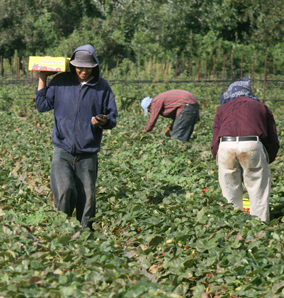
But ranchers enjoy what may have been the best year in recent
memory
If you are a rancher, you loved 2005. If you grew row crops, it
was ugly.
San Benito County Agricultural Commissioner Paul Matulich
recently released the county’s annual crop report on 2005’s
agriculture performance
– the biggest contributor to the local economy.
But ranchers enjoy what may have been the best year in recent memory
If you are a rancher, you loved 2005. If you grew row crops, it was ugly.
San Benito County Agricultural Commissioner Paul Matulich recently released the county’s annual crop report on 2005’s agriculture performance – the biggest contributor to the local economy.
While row crops took a hit from commodity pricing, overall agricultural production topped $268.8 million, edging up 1 percent over 2004’s totals.
Cattle prices contributed much to the gains in 2005, hitting the best prices Matulich has seen in 40 years. Ranching is often a tough business. Drought years force ranchers to sell off many of their cows so the rest of the herd will have enough feed, while the fickleness of commodity prices can also knock ranchers around.
“Most years it’s nip and tuck,” Matulich said.
But prices jumped last year in all categories of cattle – calves, pasture and stockers, cows, and bulls. The increase was enough to push the total cattle production from $13.5 million in 2004 to $16.5 million last year.
With Nicholas Turkey Breeders pulling up stakes and moving back east, poultry production in the county plummeted from $9.1 million in 2004 to less than $3.2 million last year.
But Matulich noted that Foster Farms has purchased the Frazier Lake facility from Nicholas and is ramping up production that will likely make up some of the lost revenue.
But there is no making up for the lost revenue in a dismal year for row crops.
Lettuce, the proverbial backbone of the county’s row-crop industry, suffered a hit in 2005 as local growers, anticipating another good year, planted an abundance of lettuce – leaf, iceberg, romaine and salad varieties. The problem is, so did many other farmers.
The increasing consumer demand for salad couldn’t offset the huge supply, causing salad lettuce prices to plummet from $3,966 per ton in 2004 to less than $2,200 per ton last year.
“The lettuce business is that way,” Matulich said. “One year you’re eating filet mignon and the next year you’re eating chicken.”
Indeed, most farmers were serving drumsticks for dinner last year. Other row crops – including broccoli, celery, onions, bell peppers, spinach, squash and tomatoes – fell victim to falling commodity prices.
Winter squash, for example, fell from $718 a ton in 2004 to barely more than $500 a ton last year, a drop of more than 30 percent. Imagine waking up one morning in any business and seeing your revenue sliced by one-third. Spinach cascaded from $2,319 a ton in 2004 to just $1,109 last year – a 52 percent plunge.
Fruit and nut growers enjoyed a remarkable year, seeing commodity prices climb at the same time yields blossomed. Countywide gross revenue climbed from $25.6 million in 2004 to more than $33.8 million last year.
While the total number of acres planted in apples, for example, decreases slightly, the per-acre production jumped from about 14 tons per acre in 2004 to nearly 18 tons last year. At the same time, prices jumped from $218 per ton to $348 per ton.
“Some years there is better pollination or the weather works out so that everything on the tree stays on the tree,” Matulich said.
This year prices are ranging from average to a little better than last year, Matulich said, but growers are facing other challenges. Growers fear that fruit such as apricots and cherries, while looking beautiful, have much lower sugar content from the unseasonably late rains this year.
Walnut growers, on the other hand, are reporting anywhere from 30 percent to 50 percent of their crops were damaged by the relentless heat spell that hit the Central Coast in July.
As any farmer will tell you, whether you eat filet mignon or chicken in any particular year is a roll of the dice.









